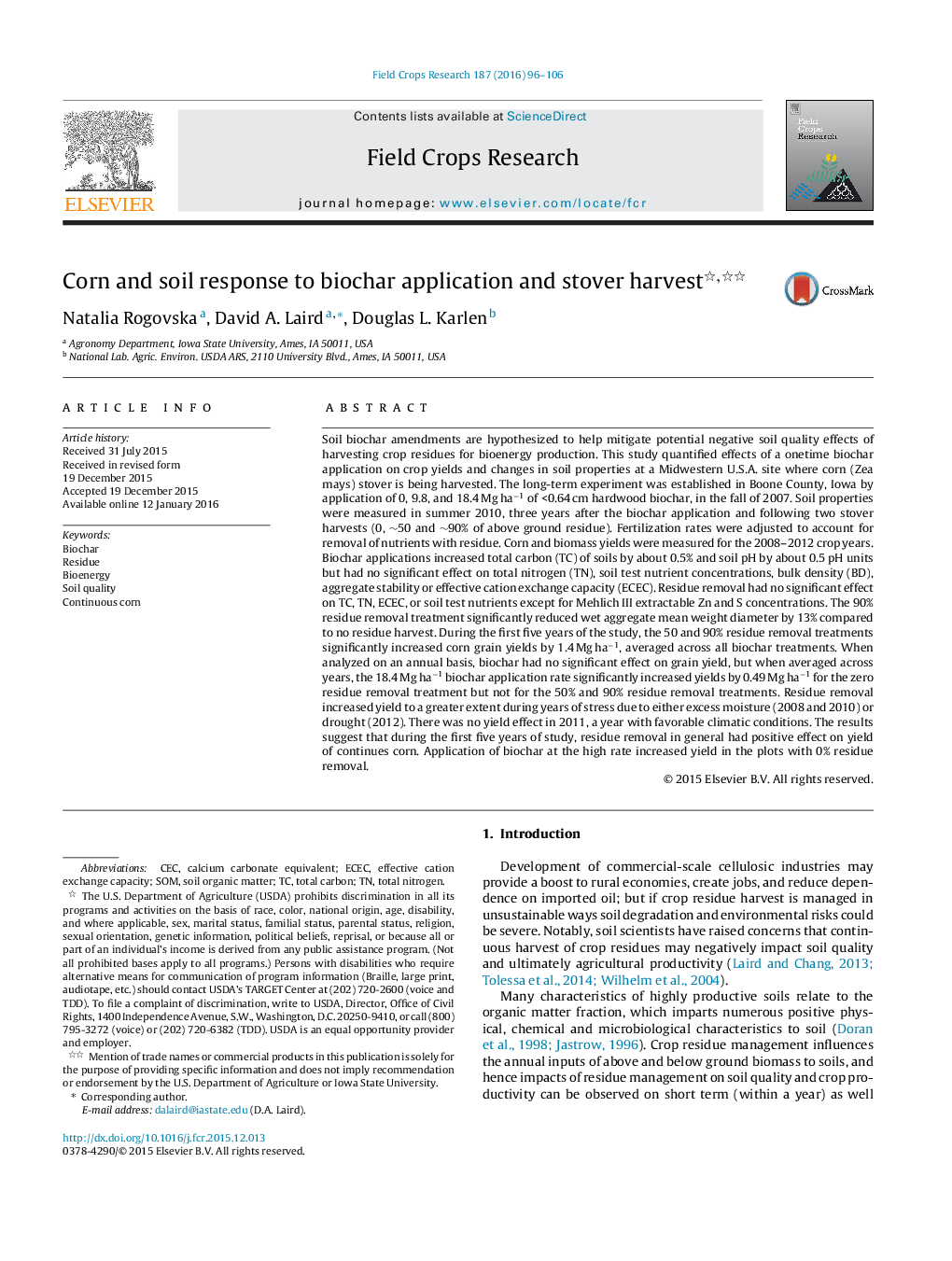| کد مقاله | کد نشریه | سال انتشار | مقاله انگلیسی | نسخه تمام متن |
|---|---|---|---|---|
| 6374727 | 1624676 | 2016 | 11 صفحه PDF | دانلود رایگان |
عنوان انگلیسی مقاله ISI
Corn and soil response to biochar application and stover harvest
ترجمه فارسی عنوان
پاسخ ذرت و خاک به کاربرد زیست فناوری و برداشت نیشکر
دانلود مقاله + سفارش ترجمه
دانلود مقاله ISI انگلیسی
رایگان برای ایرانیان
کلمات کلیدی
موضوعات مرتبط
علوم زیستی و بیوفناوری
علوم کشاورزی و بیولوژیک
علوم زراعت و اصلاح نباتات
چکیده انگلیسی
Soil biochar amendments are hypothesized to help mitigate potential negative soil quality effects of harvesting crop residues for bioenergy production. This study quantified effects of a onetime biochar application on crop yields and changes in soil properties at a Midwestern U.S.A. site where corn (Zea mays) stover is being harvested. The long-term experiment was established in Boone County, Iowa by application of 0, 9.8, and 18.4 Mg haâ1 of <0.64 cm hardwood biochar, in the fall of 2007. Soil properties were measured in summer 2010, three years after the biochar application and following two stover harvests (0, â¼50 and â¼90% of above ground residue). Fertilization rates were adjusted to account for removal of nutrients with residue. Corn and biomass yields were measured for the 2008-2012 crop years. Biochar applications increased total carbon (TC) of soils by about 0.5% and soil pH by about 0.5 pH units but had no significant effect on total nitrogen (TN), soil test nutrient concentrations, bulk density (BD), aggregate stability or effective cation exchange capacity (ECEC). Residue removal had no significant effect on TC, TN, ECEC, or soil test nutrients except for Mehlich III extractable Zn and S concentrations. The 90% residue removal treatment significantly reduced wet aggregate mean weight diameter by 13% compared to no residue harvest. During the first five years of the study, the 50 and 90% residue removal treatments significantly increased corn grain yields by 1.4 Mg haâ1, averaged across all biochar treatments. When analyzed on an annual basis, biochar had no significant effect on grain yield, but when averaged across years, the 18.4 Mg haâ1 biochar application rate significantly increased yields by 0.49 Mg haâ1 for the zero residue removal treatment but not for the 50% and 90% residue removal treatments. Residue removal increased yield to a greater extent during years of stress due to either excess moisture (2008 and 2010) or drought (2012). There was no yield effect in 2011, a year with favorable climatic conditions. The results suggest that during the first five years of study, residue removal in general had positive effect on yield of continues corn. Application of biochar at the high rate increased yield in the plots with 0% residue removal.
ناشر
Database: Elsevier - ScienceDirect (ساینس دایرکت)
Journal: Field Crops Research - Volume 187, 15 February 2016, Pages 96-106
Journal: Field Crops Research - Volume 187, 15 February 2016, Pages 96-106
نویسندگان
Natalia Rogovska, David A. Laird, Douglas L. Karlen,
